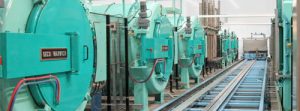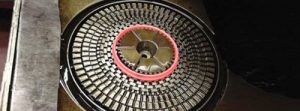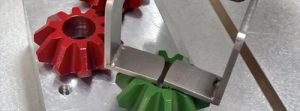
Some of Thermal Product Solutions’ ovens are used in semiconductor manufacturing. What types of oven configurations work best in this sector?
Thermal Product Solutions (TPS) has two lines of industrial ovens used for semiconductor manufacturing. One is our Gruenberg oven brand, which lends itself to being more custom in nature. Our Gruenberg ovens are built for a multitude of different industries: aerospace, semiconductor, electronics, medical device, pharmaceutical, you name it. And Gruenberg is the brand that fits when a standard offering isn’t available to meet the process requirements. The other TPS oven brand that serves the industry is Blue M. Blue M was founded in the 1960s to meet the unique manufacturing needs of the emerging semiconductor industry. If you look at some of the different models and family series within Blue M, what you’ll find is that the interior dimensions actually fit the form factor of the semiconductor products at that time.
That’s kind of how Blue M came to be. So, the majority of our semiconductor offerings that we have or that we fulfill for those needs are through the Blue M standard product line. They’ve got a heavy global presence and supply ovens to a wide range of customers. Blue M’s customer base includes a lot of niche semiconductor companies, contract fab semiconductor players, along with some of the top-tier manufacturers in the industry.
The Blue M ovens are batch ovens. We sell those ovens for various semiconductor processes where they use very high heat to attach an IHS or integrated heat spreader to the device, and lesser heat KW models to cure epoxy or resins.
Why is a sterile environment needed in an oven?
A sterile oven environment is needed to prevent contamination from particulates during processing and ensure the products pass QA requirements. Sterilization is an area that Gruenberg does really well. Their sterilization technology was actually designed to meet FDA regulations in the pharmaceutical sector and is one of the oven brands that we have that will guarantee a class 100 sterile environment inside. We typically install a port on the front of the door where customers can install an electronic particle detector inside the oven and use HEPA filtration to minimize contaminants. While the unit is running, the detector samples the air to confirm the sterile classification of the oven interior. Airflow uniformity in an oven is important. All Blue M oven airflow is horizontal, but with Gruenberg, we can do three types of airflow: horizontal, vertical, or a combination of both.
How is a Gruenberg oven made compatible with a cleanroom and why is that necessary?
To achieve the clean room design, Gruenberg and Blue M fully weld the inner liner and direct the airflow through a filter box containing a recirculation HEPA filter.
If we’re drying the board, since most boards go through a washer, they’ll come through our ovens. We also facilitate epoxy curing. Picture where they’re administering that sticky epoxy. What you really don’t want is any foreign material flying around inside the oven that’s going to stick to that, because now you’ve got a quality issue that can cause failure to the chip. That’s where the clean room models of our Blue M ovens — as well as our Gruenberg ovens —are needed.
We also offer ovens with inert atmosphere capabilities. Anytime you heat copper or some precious metals, it oxidizes, and with oxidation, the connectivity gets lost. That’s a big no-no in electronics. With inert capability, the customer can connect gaseous nitrogen to the oven, which floods the interior of the oven to force most of the oxygen out of it. With our inert ovens, there’s a 99.9 percent chance there’s going to be no oxidation.
What types of continuous process options does Gruenberg offer?
Some companies want continuous process, where they will have an engineering house automate a loading and unloading device to just constantly keep feeding this conveyor. For our continuous ovens, design considerations include the speed of the conveyor, the width of the conveyor, and the total length of the conveyor. These factors are determined by the units per hour and the process parameters the customer needs to process through the oven. We do have the luxury at TPS to kind of bounce between the two product lines to cover a multitude of customers’ products and/or production styles.
What types of applications for semiconductor manufacturing are met by Gruenberg’s ovens?
We’re helping to make chips for everything from wearable technology to microprocessors in your tablet or your laptop. We do have customers who deal in nothing but automotive electronics. There are so many custom Gruenberg ovens that are one of a kind and only built for that company and their product. We will take your product and work backwards to design an offering that fits your specific application.
Anything else you’d like to mention that we didn’t talk about?
Temperature uniformity is very important so you can have even curing, even drying, and even processing throughout the entire rack. We have a rigid set of standard tests that we run on every oven we manufacture. This ensures the equipment leaves our facility performing to our customer’s process specifications.
More Info: www.gruenberg.com
























